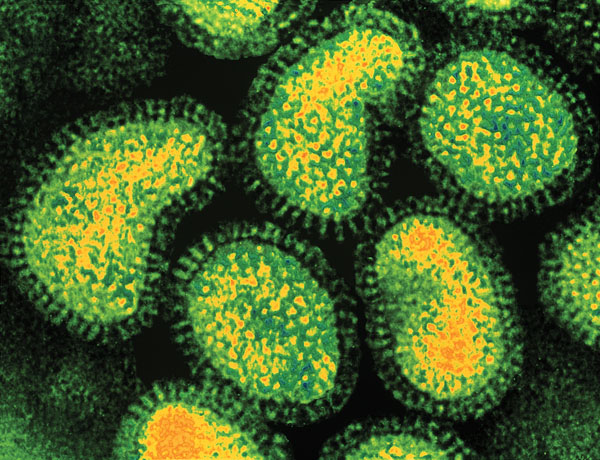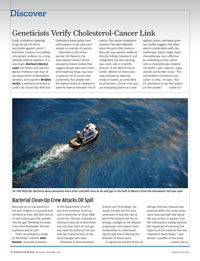Discover
Could cholesterol-lowering drugs be part of the future battle against cancer? Rochester scientists are adding new genetic evidence to a long-debated medical question.
In a new study, Hartmut (Hucky) Land, the Robert and Dorothy Markin Professor and chair of the Department of Biomedical Genetics, and coauthor Bradley Smith, a postdoctoral fellow in Land’s lab, found that defective cholesterol exportation from cells appears to be a key component in a variety of cancers.
Published in the online journal Cell Reports, the data support several recent population-based studies that suggest people who take cholesterol-lowering drugs may have a reduced risk of cancer and, conversely, that people with the highest levels of cholesterol seem to have an elevated risk of cancer.
The cancer-cholesterol question has been debated since the early 20th century. But until now, genetic evidence directly linking cholesterol and malignancy has been lacking, says Land, who is scientific director of the Wilmot Cancer Center.
Millions of Americans take cholesterol-lowering drugs or statins, as prescribed by physicians. Clinical trials also are evaluating statins as a tool against cancer, and some previous studies suggest that when used in combination with chemotherapy, statins might make chemotherapy more effective by sensitizing certain cancer cells to chemotherapy-induced cell death.
Land, however, urges caution and further study. “The link between cholesterol and cancer is clear,” he says, “but it’s premature to say that statins are the answer.”
—Leslie Orr
 TO THE RESCUE: Bacteria have consumed more than 200,000 tons of oil and gas in the Gulf of Mexico from the Deepwater Horizon
spill. (Photo: United States Navy)
TO THE RESCUE: Bacteria have consumed more than 200,000 tons of oil and gas in the Gulf of Mexico from the Deepwater Horizon
spill. (Photo: United States Navy)Bacterial Clean-Up Crew Attacks Oil Spill
Naturally occurring bacteria in the Gulf of Mexico consumed and removed at least 200,000 tons of oil and natural gas that spewed into the gulf following the disastrous 2010 Deepwater Horizon explosion and oil spill.
That’s according to a study by Rochester scientist John Kessler, associate professor in the Department of Earth and Environmental Sciences, and a researcher at Texas A&M University. The pair analyzed an extensive data set to determine not only how much oil and gas was eaten by bacteria, but also how the characteristics of the feast changed with time.
Published in Environmental Science and Technology, the results include the first measurements of how the rate at which the bacteria ate the oil and gas changed as the disaster progressed, information that’s fundamental to understanding the spill and predicting the behavior of future spills.
“A significant amount of the oil and gas that was released was retained within the ocean water more than one-half mile below the sea surface. It appears that the hydrocarbon-eating bacteria did a good job of removing the majority of the material that was retained in these layers,” says Kessler, coauthor of the study.
—Leonor Sierra
Protein Helps DNA Repair in Aging Cells
Scientists have long wondered why cells lose their ability to repair themselves as they age. Now research by Rochester scientists has uncovered two intriguing clues.
DNA strands in human cells routinely break and repair themselves, but as cells age, the repair system becomes less efficient, and flaws in the process lead to a decline in functionality and an increase in the incidence of tumors. T
o find out whether the process could be slowed or even reversed, biologists Andrei Seluanov, Vera Gorbunova, and colleagues found that the decline coincided with a global reduction in the levels of proteins involved in the repair process. The group tried to reverse the age-related decline by restoring the proteins to their original levels and found that only one protein, called SIRT6, proved effective.
The work has been published in the Proceedings of the National Academy of Sciences.
The team plans to study factors regulating SIRT6. Seluanov says that multiple groups are trying to develop drugs that activate the protein, and he hopes the research will lead to therapies that help extend lifespans and treat cancer.
—Peter Iglinski
 ARRESTING: Researchers have found a location in a gene of the flu virus that could be a “switch” to turn off its ability to spread. (Photo: Photo Researchers)
ARRESTING: Researchers have found a location in a gene of the flu virus that could be a “switch” to turn off its ability to spread. (Photo: Photo Researchers)Is There an ‘Off Switch’ for the Flu?
Rochester scientists have helped identify a location in a gene of the influenza A virus that could be used as a “switch” to disrupt the replication of the virus. If a way can be found to manipulate the switch in an organism, the researchers say it could have important implications for stopping the spread of the flu.
Conducted by Douglas Turner, professor of chemistry, and colleagues Walter Moss, Lumbini Dela-Moss, and Salvatore Priore at Rochester, and chemists Ryszard Kierzek and Elzbieta Kierzek at the Polish Academy of Sciences in Poznan, the work singled out messenger RNA, which is key to the production of two proteins the virus needs to propagate. To produce the second protein, the messenger RNA has to undergo the process of splicing, in which two remote sites of the long molecule join together, while the intervening segment is discarded.
“We look at one of the splicing sites as a potential switch,” says Turner. “If we can inactivate the switch to prevent the two sites from coming together, we can stop the virus from spreading.”
The research was published in the journal PLoS ONE.
—Peter Iglinski
A Brain-Cleansing Discovery
A previously unrecognized system that drains waste from the brain has been discovered by neuroscientists at the Medical Center. The highly organized system acts like a series of pipes that piggyback on the brain’s blood vessels, sort of a shadow plumbing system that seems to serve much the same function in the brain as the lymph system does in the rest of the body—to drain away waste products.
“Waste clearance is of central importance to every organ, and there have been long-standing questions about how the brain gets rid of its waste,” says Maiken Nedergaard, the Frank P. Smith Professor of Neurosurgery and senior author of the research, which was published online in Science Translational Medicine. “This work shows that the brain is cleansing itself in a more organized way and on a much larger scale than has been realized previously.
“We’re hopeful that these findings have implications for many conditions that involve the brain, such as traumatic brain injury, Alzheimer’s disease, stroke, and Parkinson’s disease,” she adds. Nedergaard’s team has dubbed the new system “the glymphatic system,” since it acts much like the lymphatic system but is managed by brain cells known as glial cells.
Scientists have known that cerebrospinal fluid plays an important role in cleansing brain tissue, carrying away waste products and carrying nutrients to brain tissue through a process known as diffusion. The newly discovered system circulates the fluid to every corner of the brain much more efficiently.
“It’s as if the brain has two garbage haulers—a slow one that we’ve known about, and a fast one that we’ve just met,” says Nedergaard. “Given the high rate of metabolism in the brain, and its exquisite sensitivity, it’s not surprising that its mechanisms to rid itself of waste are more specialized and extensive than previously realized.”
—Tom Rickey

